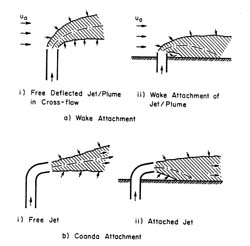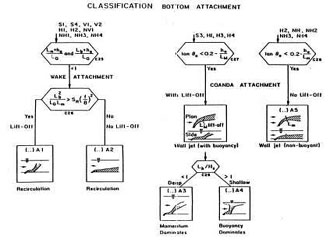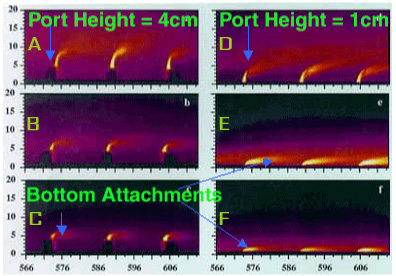Dynamic plume attachments occur when the discharge flow interacts strongly with a boundary in the near-field.
Such near-field boundary interactions present the possibility of high pollutant concentrations and
undesirable benthic impacts. Often near-field attachments are avoidable with proper outfall design.
The image on the right shows a laboratory experiment where boundary interaction occurs in the near-field.
This flow also exhibits a subsequent buoyant lift-off and an unstable near-field which is indicated by a CORMIX (..A4)
flow class suffix as described below.
Wake and Coanda Attachments
Two types of attachment are considered by CORMIX; wake attachment forced by the crossflow or Coanda attachment forced by the entrainment demand of the effluent jet itself. A physical description of these processes is given below.
- Wake Attachment:In wake attachment the presence of the discharge outfall structure and the jet efflux interrupts the ambient velocity field and causes a recirculation region in the wake downstream from the discharge.
- Coanda Attachment: When a jet discharges close to a parallel boundary located nearby, a rapid dynamic attachment can occur. This process is referred to as a "Coanda effect". It occurs because of the entrainment demand of the jet flow at its periphery. If a boundary limits the approach flow of ambient water then low pressure effects cause the jet to be deflected towards that boundary thereby forming a wall jet. Thus the mixing process of Coanda attached flow is governed by wall jet dynamics.
CORMIX Attached Flow Classws
The CORMIX methodology assigns a flow classification suffix to denote flows in which near-field dynamic attachments occur.
These flows have the A1, A2, . . ., A5 suffix designations e.g. V1A1, NH3A2, and S3A4 among others.
The suffixes are defined as follows:
- A1: Wake attached with recirculation regions and buoyant lift-off.
- A2: Wake attached with recirculation regions and without buoyant lift-off.
- A3: Coanda attached wall jet with stable near-field and buoyant lift-off.
- A4: Coanda attached wall jet with unstable near-field and buoyant lift-off.
- A5: Coanda attached wall jets without buoyant lift-off.
CORMIX also includes corresponding image, "I", flow cases for each of the cases described above for near-surface discharge with surface wake and coanda attachments.
Sensitivity Studies and Outfall Design
The CorSens sensitivity analysis tool can analyze boundary interaction and
flow classification stability for a range of discharge and source conditions.
The CorVue tool can visualize boundary interaction, density current
upstream buoyant spreading, and regulatory mixing zone boundaries.


EndView,SinglePort,30degreesBelowHoriz.jpg)



.jpg)